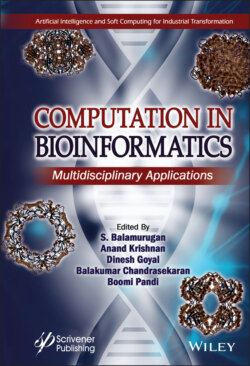Читать книгу Computation in BioInformatics - Группа авторов - Страница 34
2.3.1 Target Identification
ОглавлениеAs the main stage in the drug discovery pipeline, the recognizable proof of medication that focuses from enormous amounts of applicant macromolecules is both significant and testing. The present significant devices for target recognizable proof are genomic and proteomic approaches, which are arduous and tedious. In this manner, to supplement the test techniques, computational instruments and stages, including reverse docking and pharmacophore mapping, have been created [2, 3].
TarFisDock is a web server that recognizes potential targets utilizing a switch docking system to look for all conceivable restricting proteins for a given little molecule. The advancement of TarFisDock depended on the generally utilized docking program, DOCK (form 4.0). This stage comprises of a front-end web interface written in PHP and HTML with MySQL as database framework. DOCK is utilized as a back-end instrument for turn around docking [1–3].
The benefit of TarFisDock is self-evident; it could be a significant apparatus for distinguishing potential focuses for a compound with known organic movement, a recently confined characteristic item or a current medication whose pharmacological system is unknown. Moreover, this stage is additionally ready to discover potential focuses on that could be liable for the poisonous quality and reactions of a medication, which could take into account the expectation of the off-target impacts of a medication competitor.
For sure, review have indicated that off-target impacts have been to a great extent answerable for the high whittling down rate in target improvement. Moreover, TarFisDock could give important data to building drug target arranges so as to ponder the medication target collaboration in a progressively efficient manner. The unwavering quality of this technique has been tried on nutrient E and 4H-tamoxifen by distinguishing their putative restricting proteins.
The outcomes showed that TarFisDock could anticipate half of the revealed comparing targets. In any case, this technique still has certain constraints [1–5]:
1 The protein passages are not adequate to cover all the protein data of disease related genomes.
2 The adaptability of the proteins is not considered during the docking strategy.
3 The scoring capacity, which was planned to assess little atoms, may not be exact enough for assessing reverse docking.
A web-open potential medication target database (PDTD) was developed for TarFisDock. This database at present contains in excess of 1,100 protein sections with 3D structures acquired from the Protein Data Bank. The general data for these proteins was extricated from the writing and a few online databases, for example, TTD, Drug Bank, and Thomson Pharma. This database contains assorted data on in excess of 830 potential medication targets, and each medication target has structures in both the PDB and MOL positions.
Data on related sicknesses, organic capacities, and related flagging pathways has additionally been gathered. The entirety of the objectives was arranged by their capacity and their related sicknesses. PDTD has a catchphrase look work for parameters, for example, the PDB ID, the objective name, and the ailment name. As an extensive and one of a kind archive of medication targets, it could be utilized for in silico target objective ID, virtual screening, and the disclosure of auxiliary impacts for existing medications [2–4].
Another significant issue in target ID is finding the best connection mode between the potential objective and the little atom tests. Notwithstanding the invert docking strategy, pharmacophore displaying and mapping can be utilized to distinguish the ideal cooperation mode. A pharmacophore model is the spatial course of action of highlights fundamental for an atom to associate with a particular objective receptor. Pharm Mapper is the primary online device to utilize an “invert” pharmacophore mapping way to deal with foresee potential medication focuses against some random little atom. In any case, the Pharm Mapper server requires an adequate number of accessible pharmacophore models that portray the coupling methods of known ligands at the coupling locales. In this way, a huge, in-house database of pharmacophore models commented on with their objective data was developed (Pharm Target DB). The objective protein structures in complex with little atoms were deliberately separated from the Drug Bank, Binding DB, PDB Bind, and PDTD databases, and more than 7,000 pharmacophore models (covering data for more than 1,500 medication targets) in light of the mind-boggling structures were created.
A consecutive mix of triangle hashing (TriHash) and hereditary calculation (GA) enhancement was received to distinguish the pharmacophore that best fit the errand. Profiting by the exceptionally effective and vigorous triangle hash mapping technique, Pharm Mapper is computationally productive and can-do high throughput screens. The calculation is profoundly computerized, and the interface is easy to understand. For experienced clients, discretionary parameters controlling pace and exactness and the competitor targets subset can be unreservedly tweaked. The significant constraint of the program is that the pharmacophore database just incorporates medicate focuses on that have PDB structures with a co-solidified ligand. Be that as it may, Pharm Target DB is refreshed intermittently as the quantity of structures saved in PDB develops.
